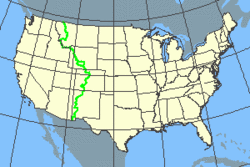Why do people turn to walking as the activity that will soothe their roiling souls?
A 33 year old recently divorced, long time overweight man who suffers from Crohn’s Disease decided to radically change his life by taking an unpaid leave from work to spend six months on a personal odyssey and hike the Continental Divide Trail, raising awareness about Crohn’s as well. The trail begins in the Big Hatchets Wilderness area in Mexico and ends 3,100 miles north in Glacier National Park on the Montana-Canada border.
Unlike the Appalachian Trail which originated around 1925 and is well blazed and fairly close to civilization, the CDT was only designated as a National Scenic Trail by Congress in 1978 and meanders far from city lights. Moreover only 72% of the trail is considered to be in its final location. Once entering the United States the trail traverses New Mexico, Colorado, Wyoming, Idaho and Montana.
The Continental Divide is a line of mountain ranges that begins in Alaska and continue into South America. The Divide divides rainfall: rain on the west wends its way to the Pacific Ocean; rainfall on the east runs into the Mississippi River system and Atlantic Ocean. The CDT could rightly be considered the ‘spine’ of the continental United States.
In couchtocdt.wordpress.com, blogger Pete decided to hike the CDT after looking in the mirror in 2011 and “seeing a sad fat and depressed person staring back”, he writes in an early blog post. The trail would be a challenge he could embrace, help cure him of his laziness and procrastination, help him lose weight and make him into someone people could look up to, he writes. And now the hike is underway. Pete posts regularly from the trail, tweets more frequently and posts his breadcrumbs on a Delorme map, techno trekking modes that are becoming commonplace among wilderness adventurers.
Is walking more of a tonic than writing? More than learning to paint? Volunteering in a soup kitchen? When the spirit is roiling, moving seems to be the preferred elixir, and moving through the grandeur of open space among mountains and valleys subject to the vagaries of mountain and valley weather seems to be the specific prescription. After more than 580 miles Pete is already sounding a more positive confident tone, especially as he offers support to others who suffer from Crohn’s. In a recent post he wrote: “I can’t imagine not being out here and I know that making it this far is a privilege that many other suffers can’t do”. Read more at: www.couchtocdt.wordpress.com


